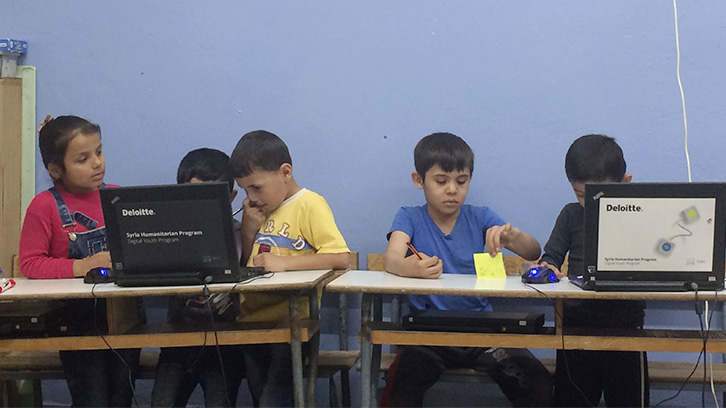Benefits of ICTs in Syrian education, a context affected by armed conflicts

Since the beginning of the conflict in Syria in 2011, more than 45% of the population has been forced into displacement, of which almost half are children. For a large part of the Syrian population, access to education has been interrupted. Statistics show that almost three million Syrian children have not had access to any type of education for more than four years.
The main objective of this research is to identify the opportunities and uses of information and communication technologies (ICTs) to guarantee access to formal and non-formal education to Syrian children affected by the armed conflict.
ICTs are not only useful to insure the access to education in the classroom, but also outside of it. In addition, ICTs can improve the communication & coordination that are key to organisational success and can significantly enhance the performance of key actors in rebuilding the education system affected by a crisis.
In order to achieve the objective of the research, three case studies have been selected and studied. The first case NAFHAM (http://www.nafham.com) witch is the first free, online platform of educational video content based on the official curriculum for students in kindergarten through 12th grade in the arab world; the second one is JUSOOR (https://www.jusoor.ngo/) witch is a nonprofit organization created by a group of Syrian expatriates and designed especially to support Syrian youth and refugees in the fields of education, career development, and global community engagement; the third case is UNICEF (http://www.unicef.org/emergencies/syria/) that operates inside and outside Syria, collaborating with the Syrian government, with the governments of neighboring host countries and with other partners in order to deliver essential services, including education to the Syrian population affected by the conflict.
The research sample is the three cases of study and its components: Syrian children, home-room teachers, school principals, parents, psychological counselors, project directors, experts in education in conflict and in humanitarian action during armed conflict, volunteers and social workers, among others.
In order to collect the data, two qualitative research techniques were used: 1. semi-structured in-depth interview and 2. Online and in situ observation. The fieldwork was developed in Lebanon during the school year 2012-2013 and 2017-2018. It had two main activities. The first with visits to the different refugee camps in Lebanon, and the second was the assistance to the classes taught within JUSOOR case study. Regarding online field work, it has consisted of observing Facebook groups and pages of each case, as well as monitoring their press releases and communications.
From the analysis of the data, it has been confirmed that ICTs can facilitate and guarantee access to education for Syrian children in different ways, both in person and remotely. As, for example, for language learning, to improve collaborative work in groups, to strengthen relations between refugee children and infants of host societies.
Also, it has been noticed that ICTs improve and speed up the communication between the academic staff, the administration of the educational institution and the parents of the children. In the same way, and in emergency situations, ICTs are the most effective tool for sharing information on the safety of children.
Likewise, the data shows that ICTs improve the performance of organizations and institutions whose objective is to offer a solution to the crisis of Syrian education in several aspects such as, for example, to specify and confirm meetings among the members of the same organization with members of other organizations or with specific individuals, exchange documents, exchange data and statistics.
In addition, ICTs are being used to raise public awareness about the education crisis in Syria and to promote solidarity with their cause.
However, despite the potential of ICT, there is a list of barriers that prevent children from having access to education continuously and safely. Of these obstacles we can mention: the armed conflict itself; language barriers in host communities; widespread child labor in the refugee camps; the lack of trained staff; the lack of quality educational infrastructure; early marriage; the psychological health of both boys and girls and their parents or teachers themselves; the lack of updated data, the poor planning of long-term projects and the lack of financing, among others.
From what has been presented, it can be concluded and affirmed that ICTs are being used extensively by key agents in case studies, whether they are parents, teachers, directors and project managers, children, as well as volunteers and social workers, not only for pedagogical purposes or in the teaching-learning process, but also for communicative and coordination purposes. They are also being used for the dissemination of relevant information on education and the crisis of education in Syria, and for the collection and management of data.
They are also used as a data collection tool since you can take pictures, make videos, voice recordings and send them immediately to the headquarters whenever there is an internet connection. It is a way of documenting the facts, and serves in the collection of data necessary for the planning of humanitarian action in relation to education, and also for the evaluation of the functioning of the actions offered at a given moment.
In conclusion, the findings can offer a pathway to find more stable solutions, but certainly research is still needed to uncover all the possibilities offered by ICTs to support education in crisis contexts such as the Syrian.
Didactic and Educational Organization Area
Universitat Autònoma de Barcelona
References
Alfarah, Mirey & Bosco, Alejandra. (2016). The role of ICTs in rebuilding education in areas of armed conflicts: The syrian case, EDULEARN16 Proceedings pp.6325-6331. DOI: 10.21125/edulearn.2016.0359


